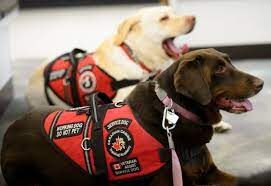 The plaque in the store read, “All dogs are service dogs, just most of them are freelancing”. As I’ve started the research phase for my next blog, this idea seemed especially relevant to what’s been filling up the nooks and crannies of my brain. It was also a sentiment which I agreed with, 100%.
The plaque in the store read, “All dogs are service dogs, just most of them are freelancing”. As I’ve started the research phase for my next blog, this idea seemed especially relevant to what’s been filling up the nooks and crannies of my brain. It was also a sentiment which I agreed with, 100%.
Count me among those who are awed when I see a service animal enter a store, sit quietly at a restaurant or guide their person across a busy street. It’s all I can do to not run over and pet every inch of their being. I only resist, because I know what a faux pas it is to distract a dog at work!
So, I thought I knew a thing or two about these amazing pups, but boy was I wrong. I’ve read a few books on service animals and support animals (not the same thing!) and countless articles. I’ve scoured the sites of dozens of organizations who train dogs, help place dogs, or just provide much needed guidance for people requiring a dog. It turns out, I have barely scratched the surface!
Needless to say, my “awe” for these critters is now off the charts, as I learn the wide variety of ways they make the lives of people living with disabilities a tad bit easier. According to the latest CDC data, over 61 million adults in the US live with a disability. That’s a full 26% of the US adult population. Unfortunately, not everyone who would benefit from a service animal, will get one, but just spreading the word on the variety of animals out there may help people in need find them, and people with means support the great organizations that are involved in this area.
Broadly speaking, there are service animals, support animals and therapy animals. Service dogs are trained to do a specific task, or tasks, to help a person with a disability. Support animals are not trained to complete tasks, but just their mere presence is enough to provide relief to someone with a disability. Therapy animals are trained, but do not necessarily only comfort disabled individuals. They are brought into facilities, and into stressful situations to comfort all those involved.
Most people are familiar with guide dogs for people who are visually impaired. These are a type of service animal. Other types help people with hearing loss, diabetes, mobility issues, and other physical limitations. Other service dogs cater to people with anxiety, PTSD (post-traumatic stress disorder), OCD, and more disorders.
Support animals can help people in a time of stress or crisis, for instance during finals week at college, a natural disaster or in the aftermath of violence at a workplace. It seems there’s no end to the variety of situations where people would benefit from a support animal. Child custody cases, post-surgery and during hospice care, for instance.
Of course, there’s also the highly trained and highly admired dogs that work with police, first responders and the military. They may be searching for lost, injured or deceased people. They may be using their amazing sniffers to track down drugs or give an early warning of cancer. Or they may be hanging out with a veteran, upon their return from a war zone. What these animals provide is beyond priceless!
So, as I pondered the plaque in the store, I thought about my own “freelancing” support pets (dogs, cats, and many more). I cannot wait to dive into each type of “professional” service or support animal, and encourage you to come along for the ride. I hope the support Comfort for Critters provides to animal shelters, and shelter pets, provides a little bit of “thanks” to all the animals that make all our lives a tad, or a lot, better.
